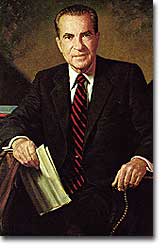3c. Federal-State Relations Today: Back to States' Rights?

Ronald Reagan and George Bush are considered architects of New Federalism, a program that allowed states to make many decisions regarding local issues. However, states were also expected to pay the bill for their own decisions, and Reagan is criticized for getting states into debt.
Ever since the critical McCullogh v. Maryland decision in 1819, the federal-state relationship has shifted more and more toward national supremacy. But some observers today believe that over the past twenty years, the balance of power is beginning to tilt back toward the states. Presidents Richard Nixon, Ronald Reagan, and George Bush tried to slow down the growth of the national government under the banner of "New Federalism."
Richard Nixon declared an open attempt to reverse the flow of power to the federal government back to the states. In his winning campaign of 1980, Ronald Reagan claimed that the federal government, in its attempts to improve society, was actually eroding individual freedoms. Then in 1994, when Republicans took control of both houses of Congress, the leaders of the "devolution revolution" attempted to return many functions to the states. But the controversial task has not been easy, since so many national responsibilities are now shared with the states.
Before the Great Depression and New Deal, experts often compared federalism to a layer cake. Each layer of government — national, state, and local — had responsibilities separated clearly by a distinct covering of "icing." This interpretation is known as dual federalism, which each level of government dominating its own sphere. The Supreme Court served as an umpire between the national government and the states in case of a dispute. But Franklin Roosevelt changed all that.
The federal New Deal programs cast the states in supporting, cooperative roles with a clearly dominant national government. However, since both levels participated in the programs, the layers began to blur.
New Federalism
One sign of the growth of the national government was the large number of categorical grants that existed by the 1960s. Congress appropriates these grants to states for a specific purpose. Funds are allocated by a precise formula with detailed conditions imposed by the national government. Often states must contribute money to match federal funds, but categorical grants almost always come with a great many "strings" that demonstrate the "supremacy" of the national government.

Richard Nixon was a major mind behind New Federalism. Nixon eased the restrictions on money that was sent to the states, believing that they were in a better position to know how to spend the money than the federal government.
For example, there is no national drinking age. In the past, some states allowed people 18 years of age or older to drink alcohol, while others set the legal drinking age at 21. Passing a national drinking age might be unconstitutional, unless Congress could prove that such legislation was "necessary and proper" to carry out their expressed powers. Congress avoided the controversy by requiring all states that receive federal highway funds to set a legal drinking age of 21. No state could afford to lose these funds, so they had no choice but to comply.
When Richard Nixon became president in 1969, he backed a revenue sharing plan that channeled federal dollars back to the states, but without the strings of categorical grants. President Reagan (1981-89) coined the movement "New Federalism" — an attempt to return power to the states.
The Reagan administration's budget and policies radically altered the relationship between the federal government and the states. For the first time in many years federal aid to states declined, and Reagan pushed to consolidate categorical grants into block grants, which had few strings and much broader categories, such as "education" or "highways." Because New Federalism meant that states often had to pay the tab for their new responsibilities, Reagan was criticized for weakening the states with debt — an opposite effect from his stated intention
Today the issue of the proper balance between national and state powers is as viable as it was in 1789. States' rights have remained a controversial topic for more than 200 years. Americans are divided about which laws should be federal, and which should be reserved to the states.
Should the right to an abortion be regulated by individual states, or should the federal government set a uniform policy? Should individual states permit the use of marijuana for medical purposes, or is drug policy a large enough problem to be decided on the federal level? Should individual states have the power to allow doctor-assisted suicide? These questions and many others shape the modern debate over state and federal power.






